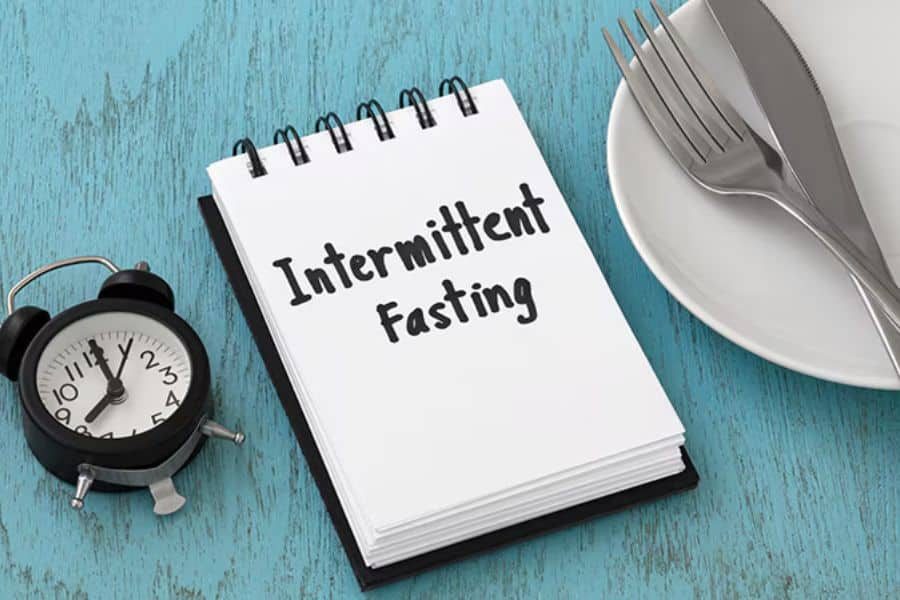Understanding Intermittent Fasting
Benefits of Intermittent Fasting
Intermittent fasting isn’t just about skipping breakfast; it’s like hitting the reset button for your health. Studies show it might just keep your organs in tip-top shape and fend off nasty diseases like diabetes, heart issues, brain disorders, and some cancers.
Here’s the scoop on what it can do for you:
- Helps your cells keep their cool during chemotherapy
- Tames those pesky inflammatory flare-ups
- Gives folks with asthma and rheumatoid arthritis a bit of a break (NCBI)
| What It Does | How It Helps |
|---|---|
| Disease Shield | Stands guard against diabetes, heart mischief, cancer, and brain trouble |
| Cell Health Boost | Plays defense against oxidative nasties, fine-tunes energy use |
| Inflammation Wrangler | Soothes inflammation, a boon for asthma and arthritis folks |
If you’re thirsty for more knowledge, check out our article spilling more tea on intermittent fasting benefits.
Intermittent Fasting Explained
So, what’s the deal with intermittent fasting (IF)? It’s all about the clock, not the plate. You eat and then you don’t. People have been doing it since way back, and yeah, science is catching up with the reasons why it’s beneficial.
Fasting gets your cells working smarter, guarding them against damage and giving your energy systems a little tune-up. It also kicks in autophagy, which sounds big and science-y but just means your cells clean house, getting rid of junk and making room for the new. It’s like a detox your body signed up for.
Popular ways to fast include:
- Alternate-Day Fasting: Pig out today, hit pause tomorrow.
- Time-Restricted Eating: Chow down only between certain hours. Think of it as dinner at 6, goodbye at 8.
Pick one that jives with your life routine. Need more deets on timing? We’ve got you covered with an intermittent fasting schedule and also a handy intermittent fasting meal plan.
When you hop on the fasting train, your body goes through some intriguing changes. Your system hits the fat-burning zone, shakes up its usual pathways, and gets better at keeping things tight against stress. Also, it adds a little autophagy magic. These changes don’t just make you feel good; they stock you up with health points and a defense system ready for modern life.
If you’re a fresh face in the fasting scene, ease into it slowly and chat with a doc to make sure everything checks out with your health. For rookie tips, peek at our intermittent fasting for beginners guide.
Autophagy and Its Role
Cellular Recycling System
Autophagy is kinda like your body’s spring-cleaning routine, but on a microscopic level. It’s a process where cells take apart old or busted parts and reuse them to make something new, while tossing out the junk. This nifty system keeps cells humming along nicely and is key to healthy cellular function.
Think of autophagy as your cell maintenance crew, getting rid of misfolded proteins and fixing up any broken-down organelles. This process backs up essential cell activities like developing and regenerating.
Importance of Autophagy
As you get older, your autophagy game can weaken, leading to a build-up of cellular trash and tired cells. Giving autophagy a boost might just be your ticket to living longer and feeling better overall.
When autophagy is in full swing, here’s what happens:
- Tidy-Up Time: Clears out messed-up proteins and organelles, fine-tuning cell functions.
- Body Armor: Shields against diseases by keeping cells in tip-top shape.
- Repair Mode: Is essential for intermittent fasting benefits, helping cells repair and renew themselves.
In the mix of intermittent fasting and autophagy, fasting gets autophagy fired up, which can perk up heart health, assist in managing weight, and spruce up metabolic wellness. It also tones down the mTORC1 pathway, which is a good thing because it helps protect cells from nasty stuff like liver damage and improves how your body handles insulin.
Understanding how intermittent fasting and autophagy team up can help you ride the wave of intermittent fasting results for better health and weight goals. Curious about hopping on the fasting bandwagon? Check out our simple guide on intermittent fasting for beginners.
Intermittent Fasting and Autophagy
Connection Between Fasting and Autophagy
Think of autophagy as your body’s internal cleanup crew, tidying up and recycling those worn-out parts of your cells. When you give intermittent fasting a go, you’re actually giving this process a green light. By depriving it of its usual fuel source, your body kicks off autophagy to find its own energy.
Research flashes a spotlight on how intermittent fasting gives a boost to autophagic flux through lysosomes (PubMed Central). In simpler terms, fasting sweeps out the cellular junk, encouraging efficiency and better performance throughout your body.
A key player in this process is mTORC1, a protein that typically keeps autophagy in check when you’re eating. But when you skip meals, mTORC1 takes a backseat, ramping up autophagy. This extra focus helps protect against problems like liver damage and can even tweak your insulin sensitivity (NCBI).
Cellular Benefits of Autophagy
Autophagy, fired up by intermittent fasting, packs a punch for your health in a few cool ways:
- Tuning Up Energy Use:
- Your energy use becomes more efficient, cutting down on the cell wear and tear caused by those sneaky free radicals (NCBI).
- Heart Helper:
- Autophagy keeps your ticker ticking smoothly, especially when food is off the table. AMPK gets in on this by shielding heart cells when things get rough.
- Disease Defender:
- Fasting boosts autophagy, potentially fortifying your defenses against diabetes, cancer, cardiovascular hiccups, and brain disorders.
- Upping Cellular Game:
- Going without grub kicks off ketogenesis, tweaking metabolic pathways, and reinforcing cell protection (NCBI).
| Cellular Benefit | Description |
|---|---|
| Tuning Up Energy | Trims oxidative harm, refines metabolism |
| Heart Helper | Supports heart cells when fasting |
| Disease Defender | Backs up against diabetes, cancer, heart diseases |
| Upping Cellular Game | Sparks ketogenesis, helps metabolism |
By seeing how intermittent fasting amps up autophagy, you’re in a great spot to understand why fasting is worth a shot for better health. If you’re itching to jump in, our beginner’s guide to intermittent fasting is a handy starting point. For more on how fasting might benefit you, head over to intermittent fasting benefits.
If you want a more hands-on approach, an intermittent fasting meal plan could help you make the most of your fasting while combining it with exercise routines for maximum gains.
Types of Intermittent Fasting
Gettin’ to grips with different styles of intermittent fasting can help you figure out what works best for your life and goals. We’re gonna chat about two favorites: Alternate-Day Fasting and Time-Restricted Feeding.
Alternate-Day Fasting
Alternate-Day Fasting (ADF) is all about flipping between regular eating days and fasting days where you munch on very little. On your fasting days, you chow down about 500-600 calories, and on those eat-anything days, you can nosh normally.
ADF works great for losing some weight. Some studies say it’s as good as your usual low-calorie diet for shaving off pounds. Besides slimmin’ down, ADF seems to boost brain power, crank up insulin sensitivity, and chill out that stress.
| Everyday | Normal Days | Fasting Days |
|---|---|---|
| Calorie Count | Normal grub | 500-600 cals |
| Perks | Boosts brains, Insulin helper | Weight loss, Stress fighter |
| Ideal For | Weight watch, Turning up metabolism | Brain breathe, Heart warm |
ADF might also keep your ticker happy. In some mouse studies, six weeks of ADF bumped up autophagy and offered some heart protection by shrinking heart damage. Wanna give it a go? Check out our intermittent fasting schedule guide.
Time-Restricted Feeding
Time-Restricted Feeding (TRF) means you eat your grub in a set time slot daily, usually around 6 to 10 hours, then hit the fasting button for the rest. Popular among ‘em is the 16/8 gig, where you fast for 16 hours and feast in a cozy 8-hour eat-up window.
TRF is said to be a metabolism booster, helps with weight stuff, and kicks up some autophagy magic. Unlike ADF, TRF’s a smoother ride as there’s no big cutback on what you eat—it’s just about when you dig in.
| Schedule | Eating Time | No-eating Time |
|---|---|---|
| Usual Plan | 8 hours | 16 hours |
| Perks | Rev up metabolism, Weight check | Autophagy, Chill inflammation |
| Ideal For | Slide it into everyday | Staying healthy |
TRF is also a buddy for long life and keeping bad-day diseases away. For more on how TRF can jazz up your health, pop over to our piece on intermittent fasting benefits.
By scoping out these types of fasting, you can pick a path that vibes with your health and lifestyle. Whether Alternate-Day Fasting or Time-Restricted Feeding is your jam, remember, it’s crucial to think about personal health and have a chinwag with a health pro before jumpin’ into any new eating plans. For tailored hints on fasting and working out, don’t miss our intermittent fasting and exercise guide.
Health Effects of Intermittent Fasting
Who knew skipping breakfast could possibly offer more than just a simpler morning routine? Intermittent fasting isn’t just a passing fad; it packs a punch for your health that might just make those hunger pangs worth it. Whether you’re battling stubborn belly fat or want to keep chronic illnesses at bay, this eating pattern might just have you covered.
Impact on Chronic Diseases
Getting to the nitty-gritty of it, intermittent fasting may be your buddy in managing chronic diseases. It’s been playing a role in reducing inflammation—an annoying culprit in conditions like asthma and rheumatoid arthritis. And those rambunctious rodents in research labs seem to live longer and with better heart health when given the opportunity to fast a bit.
On a more serious note, if chemotherapy is part of your reality, fasting may lend a hand. Healthy cells can potentially toughen up against the treatment, reducing injury (NCBI). And with obesity-related issues like diabetes and sleep apnea, skipping a shawarma every now and then might lower your risk, thanks to its knack for weight loss and getting you off the couch more often.
For the ins and outs on why you might want to make friends with fasting, our intermittent fasting benefits guide will keep you in the loop.
Weight Management and Metabolism
Trying to shimmy out of that holiday weight gain? Intermittent fasting might just dance around your metabolism, offering a hand with weight management. By setting eating windows, it’s sneaky like other low-calorie diets in helping drop those pounds.
And speaking of cellular games, fasting takes a step further with autophagy. It’s the body’s version of Marie Kondo, cleaning out malfunctioning cells and tidying up with new ones, which leads to the betterment of cellular health.
Need a road map for this fasting journey? Our guides for intermittent fasting beginners and meal planning are here to help steer the way.
| Health Benefit | Intermittent Fasting Effect |
|---|---|
| Inflammation | Cuts down on pesky inflammation (NCBI) |
| Chemotherapy Resistance | Gives healthy cells a fighting chance (NCBI) |
| Obesity-Related Diseases | Helps keep extra pounds at bay (Mayo Clinic) |
Peek behind the curtain of intermittent fasting and autophagy to fuel your brain and bolster your motivation. If number crunching is your speed, the results on weight loss with intermittent fasting offer food for thought—without the calories.
Considerations and Precautions
Consultation Before You Start
Even though intermittent fasting sounds like a magic wand for losing weight and boosting health, don’t just jump into it. Have a chat with your doctor first. Everyone’s unique, and what works wonders for one person might not for another. This is especially true if you’re pregnant, nursing, or dealing with stuff like kidney stones, acid reflux, or diabetes. Get some professional advice to see if fasting is your jam (Johns Hopkins Medicine).
For the new kids on the fasting block, it’s smart to have a clear plan. Expert guidance can help you dodge risks and make the whole process smoother. Think of it like having a GPS for your diet.
What You Might Feel
Diving into fasting? Your body might have a few things to say about it. Sure, it comes with perks, but there could be a few bumps on the road. Here’s a quick look at some common feels and how long they might last:
| Feeling | How Long You’ll Feel It |
|---|---|
| Hunger | 1-2 Weeks |
| Tiredness | Up to a Month |
| Dizzy Spells | Up to a Month |
| Short Fuse | 1-2 Weeks |
| Head Thumps | 1-2 Weeks |
| Tummy Trouble | 1-2 Weeks |
If you’re in it for the long haul with fasting, keeping yourself hydrated and munching on the right nutrients can help tame these annoyances. And if you still feel off, ring up your doctor to chat about tweaking your plan.
Mixing fasting with workouts? Keep an ear to your body’s signals. You might need to shake up your exercise habits to keep pace with your fasting routine. Eating right before and after workouts helps keep your pep up and aids recovery.
Switching up your eating habits is no small feat. Keep your ears open to your body’s cues and tweak your strategy as you go. To really nail your fasting journey, swing by our article on intermittent fasting meal plans for a little more guidance.










